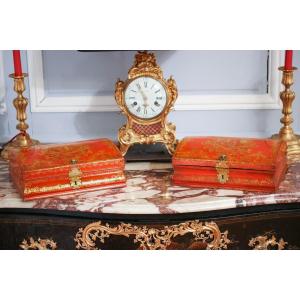"Very Rare Pair Of Toilet Boxes In Red And Gold Varnish"
Very rare pair of lockable red and gold varnish toilet boxes. The decoration represents in the center within cartridges Pyche, Eros (cupid) and Venus. Around the main scenes, a rich decoration of acanthus leaves, fruit baskets and scrolls is deployed. Probable work by Guillaume Martin Louis The pair of boxes in our study are extremely rare and belong to the intimate domain: they are moving objects, witnesses to the luxury of this era. These are toilet boxes, called "squares" in 18th century descriptions, and unfortunately often wrongly called "wig boxes". These boxes, at the very beginning of the 18th century, were either in the form of a tomb or like our pair, that is to say rectangular with a domed lid. They were used to store brushes, combs, “bottles of scented water”, jewelry or items of adornment. They were then made in pairs but today are very often found alone. They were then placed on each side of the dressing mirror (mirror which was placed on a table reserved for this purpose). These boxes took the shape of silver toilet objects. They do not make the latter disappear and after their creation mix with the pieces of goldsmithing. The painting kept at the Nelson-Atkins Museum of Art after Jean-François de Troy makes it easy to understand their installations. What makes them rare is not only that the set is complete, it is also their dating. The decor on a captivating red background is characteristic of the production of the years 1710-1720. In fact, these are the beginnings of the production of European varnish boxes. This is why the two boxes in our study are historical objects. We can compare the works in our study to those kept at the Victoria and Albert Museum from the same period. This said varnish made it possible to design decorations of great finesse. It is enough to observe them in the two main cartridges using a magnifying glass to appreciate the detailed landscapes in the background, particularly as the drawings are complex. The technique is as follows: the frame of the object received the colored layers, the miniature painter or the engraver produced the ornamentation which was covered with a mordant; gold leaf, powder or in the form of a mixture was applied and finally everything was covered with layers of translucent lacquer. It is then a “new subject”, and professions linked to it are created. In this unique production, it is the “varnish engravers” who are authorized to work on the ornamentation (the conventions do not allow other trades to experiment with this know-how). Thus, the profession and the technique develop. The evolution will go in the 1730s towards the imitation of Asian lacquers. We are abandoning the “French” decorations as presented on our pair of boxes in favor of those evoking the Far East. They also enjoyed wide distribution throughout the 18th century. These rare witnesses from the beginning of the century were perhaps made by Guillaume Martin and his workshops. Indeed, the craftsman giving birth to a famous varnisher dynasty, innovates and marks the history of lacquer. He became “varnisher to the king” from 1725. Historians agree that Guillaume and his brothers established themselves in this field between 1710 and 1730 against their competitors. In documents contemporary with this one we find the title “Guillaume Martin varnisher at Verny de la Chine as much on wood, dumpster, yvoir as for others as well as for women's toilets as well as other works”. We know that at this time toilet objects and in particular square boxes were major in his work. They were very expensive. The more complex the decor, the more significant the price, as Anne Forray-Carlier explains to us in the book “The secrets of French lacquer” (Editions Les Arts Décoratifs). By choosing certain borders or details, the sponsor had a multiple choice of possibilities. Amusing anecdote, the Duke of Bouillon owed the Martins 200 pounds (that is to say a very large sum). We notice that the works in our study have a well-made handmade decoration since the two boxes have some differences in the engraving (for example not the same number of crosspieces in the corners). They present in the cartridges the myth of Psyche and Eros (Cupid). Venus, the mother of Eros, represented as a small winged putto equipped with her arrows, is jealous of Psyche's beauty and tells the cherub to send an arrow to Psyche so that she falls in love with a qualified mortal of the ugliest ever. Cupid, captivated by the beauty of the young girl, accidentally pricks himself and falls in love with her. The latter is sometimes represented as a child like here and wears butterfly wings. The subject of Love to which these boxes refer indicates that it may be a wedding gift.



